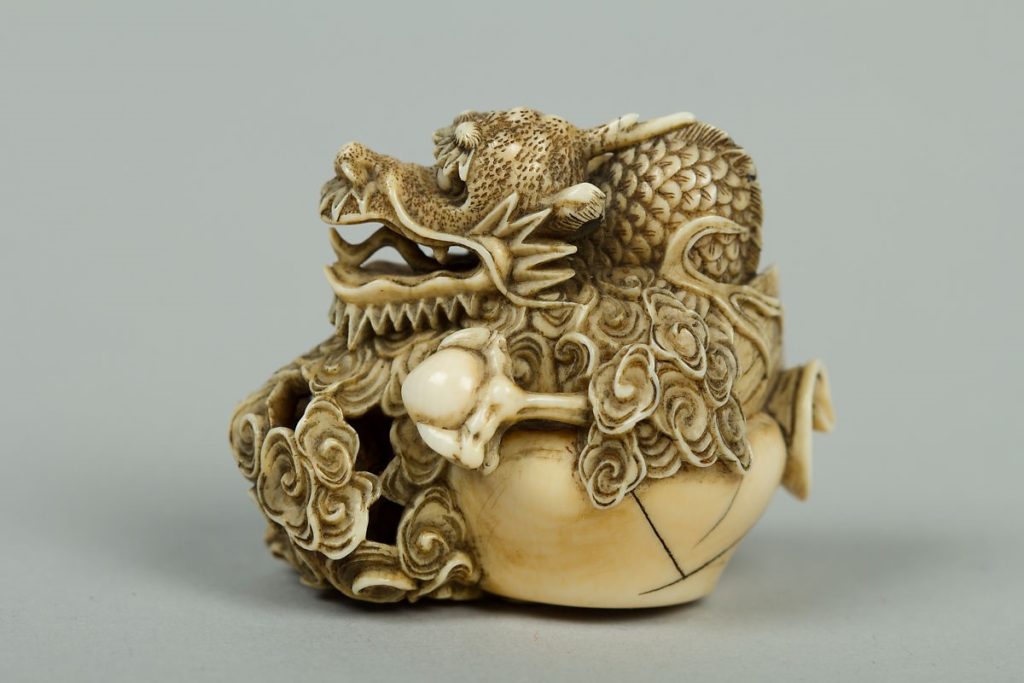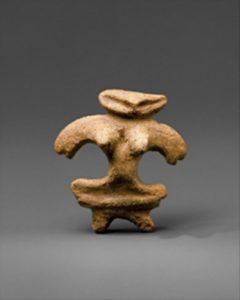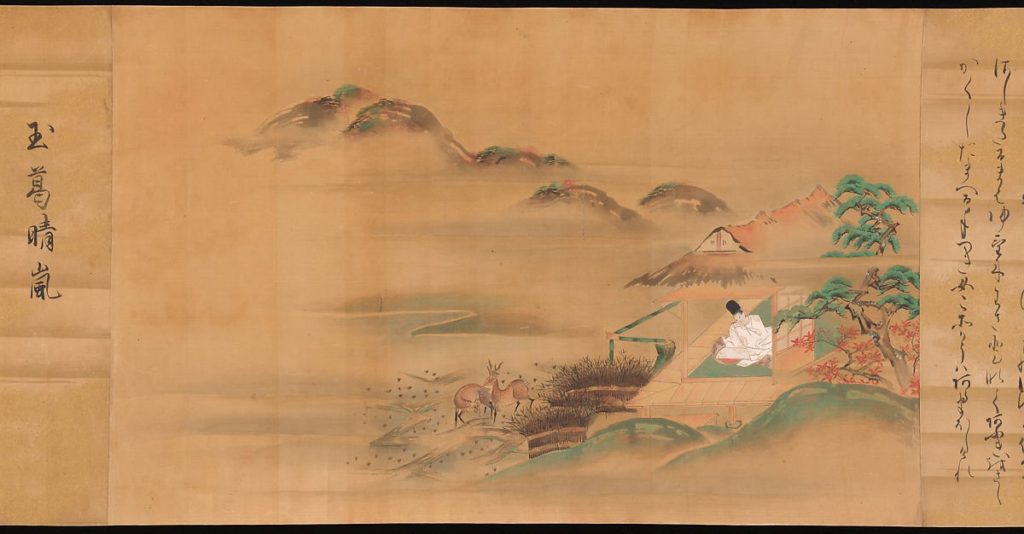by Margaret Soden, Office of Public Works, Farmleigh.
If you were asked to jot down five objects that signify the material culture of Japan, what would you come up with?
My list includes, The Kimono, Samurai warriors, Sushi, that wave print (I now know as The Great Wave off Kanagawa by Hokusai!) and finally Netsuke; exquisitely carved little toggles used to attach small objects to the sashes on men’s kimonos.
I came across Netsuke on reading The Hare with Amber Eyes: A hidden inheritance by Edmund de Waal ( brilliant!) c ten years ago, and promptly hot footed it into the Chester Beatty Library to see it’s stunning collection of delicately carved miniature artefacts. I highly recommend both the book and a visit to the Chester Beatty Library!

Netsuke of Jewel-Holding Dragon Period: Edo period (1615–1868) Culture: Japan Medium: Ivory. Metropolitan Museum New York
Chances are we overlapped in our choice of items; did anyone list Japanese dolls? The Hina Matsuri festival also referred to as Girls Day occurs on the 3rd of March annually, the focal point of the celebration are the culturally charged Hina Matsuri dolls.
As Farmleigh House is the State Guesthouse artefacts which serve to acknowledge and celebrate cross cultural heritage are highly significant. This blog considers the material culture of two exquisitely crafted Imperial dolls housed here at Farmleigh. As they are fragile they are not on continuous display. However once a year on Experience Japan day, they are exhibited in a prominent position from whence they command the attention and admiration of all who enter their orbit.

Two Dairi-bina dolls of the Taisho Period (1912-1926) presented to W.B. Yeats by Dr Yano Kazumi in 1927
The dolls were gifted to W.B. Yeats by Japanese essayist and poet Dr Yano Kazumi when he visited Yeats at Thoor Ballylee Co Galway in 1927. At that time Kazumi was in the process of preparing a Japanese edition of The Selected Poems of W.B. Yeats and was seeking Yeat’s assistance with the foreword or commentary for the work.1
A doll by any other name!
The intricately crafted dolls are interchangeably referred to as Ningyo, Dairi-bina or Hina Matsuri Dolls. It transpires that all three terms legitimately apply to the “Farmleigh” set. In the first instance Ningyo literally translates as “Human Form “, Dairi–bina as “Lord and Lady from the inner palace “and finally Hina Matsuri refers to the size of the dolls and the festival they give rise to.
In Japan Dairi-bina dolls represent a high ranking couple from the Imperial Court, while here in the west these particular figurines are more generally referred to as Emperor and Empress Dolls. In large public displays the imperial couple always occupy the dominant position in tiered exhibition cases which often contain upwards of fifteen dolls and their accoutrements.

Dogū (Clay Figurine) Final Jōmon period (ca. 1000–300 B.C.) Culture: Japan Medium: Earthenware Dimensions 5.7 cm W. 4.8 cm The Metropolitan Museum of Art New York
Human figurines and doll like artefacts feature in the material culture of many countries and indeed many civilizations. However, for some inexplicable reason, in Japan their cultural significance has not only endured but has intensified with the passage of time. Think Anime, Manga, Hello Kitty and even contemporary Japanese cosplay!
Doll like figures referred to as Dogú, first appeared in Japan in the Jomón era (14000 BCE to 300 BCE)2. Archaeologists and Anthropologists surmise that that the figures were the focal point of a healing ritual whereby a person’s aliment or affliction was reassigned to a doll. In the final stages of the ceremony it seems that the doll was intentionally shattered and disposed of arbitrarily as shards have been unearthed in a variety of settings.3 Other obviously female Dogú are associated with pregnancy rites. Over time Japanese dolls accumulated many additional talismanic qualities. Century’s later young girl’s crafted dolls out of paper for a cleansing ritual in which the dolls assumed their respective misdemeanours. The paper figures were placed in a stream or river and floated away taking all transgressions with them.4
The Farmleigh Dolls
The Dairi- bina dolls at Farmleigh are approximately 31 cm high and are arranged in the traditional 17th century pyramidal format. They exemplify the craftsmanship and luxury associated with high quality artefacts.
In the 17th century doll makers developed a pyramidal format for a male-female doll pair to be displayed on March 3rd. They represent seated (i.e. kneeling or sitting cross-legged on a cushion) courtiers in the Emperor’s dairi, or residence at his palace.5
The configuration is achieved by mixing and moulding wood and straw into the required shape. The dolls wooden limbs and faces are probably painted with gofun; an opaque white pigment made from crushed oyster shells mixed with rice glue6 which gives their faces a strange luminous quality. The hair is silk although human hair was often used when crafting high quality dolls.
Their exquisite costumes are fashioned out of a silk brocade or a silk damask and represent the style or design worn by high ranking couriers during the Heian Period (794-1185 BC). The attention to detail in devising the costumes is particularly impressive. The Empress wears an elaborate Chinese style crown while the sleeves of her robe are composed of several layers of folded fabric to create the impression she is wearing a Juunihitoe, a multi -layered robe worn by the high ranking ladies of the imperial palace. Positioned to her right the Emperor wears a black lacquered ceremonial kanmuri on his head and holds a shaku or flat ritual baton in his right hand.7
Japan establishes its own unique cultural identity
The Heian period (so named because the imperial capital was moved to Heian-keó modern day Kyoto in 794 BC) marked a period of unparalleled stability in Japanese history. It also marks the point at which Japan began to move out of China’s shadow and establish its own unique cultural identity. Significantly it is the era in which Japanese fine arts and literature flourished.
The Fujiwara family are synonymous with the Heian era. They were commoners who came to political power by marrying their daughters into the Imperial family and then controlling the heirs born out of those unions8. The Tale of the Genji , considered by some to be the world’s first ever novel and one of Japans most celebrated literary works was written by Murasaki Shikibui (not her actual birth name) c 1010 CE.

Eight Views from The Tale of Genji Artist: Ishiyama Moroka (Japanese, 1669–1734) Edo period (1615–1868) Medium: Handscroll; ink, colour, and gold on silk Culture: Japan. Metropolitan Museum New York.
The author was born into a middle ranking faction of the all-powerful Fujiwara family. She rose to the position of lady in waiting to the Empress Akiko (988-1074 CE) and as such would have witnessed the politics culture and lifestyles of the upper echelon within the Imperial Court.9
Aside from its literary significance, the novel provides an invaluable insight into all aspects of court life including the subtleties to be observed in terms of dress code, and the role of dolls within Japanese culture.
Only the nurse and a personable young woman called Shosho got into the little girl’s carriage, taking with them the sword Genji had sent to Akashi [where the child was born] and a sacred guardian doll. Tale of the Genji Chapter 19 https://people.clas.ufl.edu/jshoaf/japanese-dolls/genji/
The Yeats Connection

William Butler Yeats. c. 1915 Repository: Library of Congress, Prints and Photographs Division, Washington, D.C. 20540 USA, hdl.loc.gov/loc.pnp/pp.print
W.B. Yeat’s appreciation of Japanese culture predates Kazumi’s gift of the dolls by almost fourteen years. Ezra Pound introduced Yeats to Noh Theatre c 1913; its symbolism and format had an immediate and profound impact on the poet.
“With the help of Japanese plays ‘translated by Ernest Fenollosa and edited by Ezra Pound,‘ I have invented a new form of drama, distinguished, indirect, and symbolic...”10
Noh drama is the oldest surviving form of Japanese theatre. It combines music, dance, and acting to communicate Buddhist themes and recreate famous scenes from classical Japanese literature including The Tale of Genji.11
Masks are an essential element of a Noh performance and the symbolism, materials and skill involved in producing them is matched or replicated in crafting high quality Japanese dolls. Yeats was most likely aware of this association, if he wasn’t, Dr Kazumi certainly was.
Kazumi’s gift of the Dairi-bina dolls was symbolic on so many levels, not least as an acknowledgment and appreciation of Yeat’s aesthetic and personal affinity with and celebration of Japanese art forms and Japanese sensibilities.
………………………………………………………………………………………………………………………………………………………….
Experience Japan Day a one day festival staged at Farmleigh annually in mid – April incorporates a series of cultural events: traditional music and dance, opportunities to try on Kimonos , engage with bonsai practitioners or even talk with proponents of modem Japanese cosplay many of whom dress up as contemporary versions of the culturally laden Japanese doll on the day!
The festival normally coincides with the blossoming of the Cherry Trees here at Farmleigh and of course provides a rare opportunity to view W.B. Yeat’s Dairi- Bina dolls up close!
References
- Strange Intimacy: Yeats’s Adaptation of the Noh Drama in Four Plays for Dancers – csun.edu
- Dogū (Clay Figurine) 1000–300 BC – metmuseum.org
- heritageofjapan.wordpress.com/just-what-was-so-amazing-about-jomon-japan/ways-of-the-jomon-world-2/jomon-crafts-and-what-they-were-for/the-mystery-of-the-clay-dolls
- Hinamatsuri and the Japanese Female: A Critical Interpretation of the Japanese Doll Festival Salvador Jimenez Murguia, Miyazaki International College. Journal of Asia Pacific Studies (2011) Volume 2 No 2, 231-247. – pdfs.semanticscholar.org
- Traditional Doll Shapes Judy Shoaf College of Liberal Arts and Sciences – people.clas.ufl.edu
- Traditional Doll Shapes Judy Shoaf College of Liberal Arts and Sciences – people.clas.ufl.edu
- The Hina Matsuri – A Living Tradition – Text by Alan Pate – antiquejapanesedolls.com
- Heian Period Japanese History Encyclopædia Britannica – britannica.com
- Murasaki Shikibu – newworldencyclopedia.org
- Strange Intimacy: Yeats’s Adaptation of the Noh Drama in Four Plays for Dancers – csun.edu
- Noh Drama- Asia for Educators – afe.easia.columbia.edu
Images
Jewel-Holding Dragon Period, Edo period (1615–1868), 18th century Culture, Japan, Ivory, Metropolitan Museum New York – metmuseum.org
Dairi- bina dolls of the Taisho Period, OPW, Farmleigh House
Dogū (Clay Figurine), Final Jōmon period (ca. 1000–300 B.C.), Japan, Earthenware, Dimensions 5.7 cm W. 4.8 cm, The Metropolitan Museum of Art New York – metmuseum.org
Eight Views from The Tale of Genji, Ishiyama Moroka (Japanese, 1669–1734), Edo period (1615–1868), Japan, Handscroll; ink, colour, and gold on silk. – metmuseum.org
Repository: Library of Congress, Prints and Photographs Division, Washington, D.C. 20540, USA. – hdl.loc.gov


